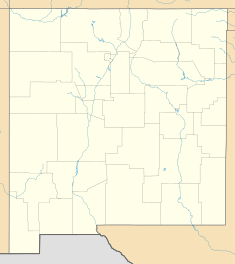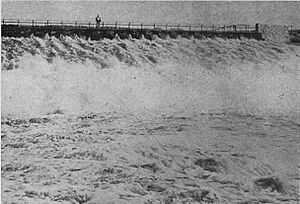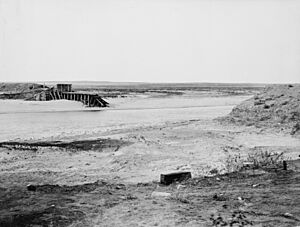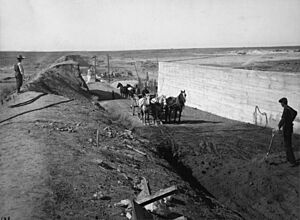Avalon Dam facts for kids
Quick facts for kids Avalon Dam |
|
|---|---|
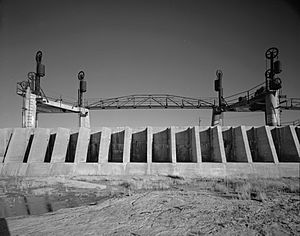
Spillway #2
|
|
|
Location of Avalon Dam in New Mexico
|
|
| Country | United States |
| Location | Eddy County, New Mexico |
| Coordinates | 32°29′27″N 104°15′08″W / 32.490796°N 104.252119°W |
| Purpose | Irrigation and flood control |
| Opening date | 1888 |
| Owner(s) | United States Bureau of Reclamation |
| Dam and spillways | |
| Height | 60 feet (18 m) |
| Reservoir | |
| Total capacity | 202,000 cubic yards (154,000 m3) |
The Avalon Dam is a dam located on the Pecos River in New Mexico, United States. It's about 5 miles (8 km) north of the city of Carlsbad, New Mexico. This dam helps store and control water, sending it into a main canal for the Carlsbad Irrigation District. This water is super important for farming in the area! The dam also helps prevent floods.
Contents
Where is Avalon Dam?
The Pecos River starts in the mountains near Santa Fe, New Mexico. It then flows through the flat plains of southeastern New Mexico. Summers here can be very hot, sometimes reaching 111°F (44°C). On average, the area only gets about 12.5 inches (32 cm) of rain each year. However, big storms can bring heavy rainfall, causing sudden floods. In the late 1800s, people wanted to farm in the Pecos Valley. But they needed a way to get water to their crops, so irrigation was a must-have.
History of Avalon Dam
The Avalon Dam was first built in 1888 by a group of private business people. It was made of earth. Sadly, a flood washed it away in 1893. It was quickly rebuilt, but another big flood in 1904 destroyed it again. In 1907, the United States Bureau of Reclamation rebuilt the dam. Its height was increased in 1912 and again in 1936.
Early Dams and Floods
Some local ranchers, like Charles B. Eddy and Pat Garrett, saw a chance to make money. They planned to irrigate the valley and sell or lease land to new settlers. They started an irrigation company and got money from investors like James John Hagerman. He had become rich from a silver mine.
The new company began building the Avalon Dam and other large irrigation systems. Hagerman and his partners became the main owners. They changed the company, started a railroad, and promoted a new town. This town was first called Eddy, but later its name was changed to Carlsbad.
The dam was finished in 1889, north of the town. It was one of the first dams in the U.S. built from loose rock with an earth face on the upstream side. It had a clever gate that sent river water into the main canal. There was also a long, wide wooden bridge, called a flume. It was so big that four teams of mules could walk across it side-by-side!
Just four years later, in 1893, a flood broke over the dam. It damaged the new canals and the huge flume.
The company didn't waste time. They hired 500 men and 165 horse teams to quickly rebuild the dam. It was almost exactly like the first one. The flume and canals were also fixed in time for the 1894 farming season. Farmers did have trouble finding crops that grew well in the soil and climate.
From 1902 to 1903, the Pecos Irrigation Company spent more money to make the flume stronger. They added concrete and four pairs of arches. People were very proud of this large and beautiful flume. It was 497 feet (151 m) long and 47 feet (14 m) high. It was said to be the biggest irrigation flume in the United States.
Soon after the flume was finished, in October 1904, another flash flood hit the Pecos River. This flood caused huge damage to the dam, the canals, and the highway and railroad bridges.
The Dam Built by the Government
The farmers needed water to grow their crops, and the Pecos Irrigation Company was almost out of money. The settlers formed a group called the Pecos Water Users Association. They strongly asked the government's new Reclamation Service (now called the Bureau of Reclamation) to take over the project.
In December 1904, engineers from the Reclamation Service came to study the problem. While they were deciding, the Pecos Water Users Association raised $20,000. With help from the engineers, they made temporary fixes to Avalon Dam. But the dam broke again when a serious leak caused it to fail just hours after the reservoir was filled. In November 1905, the Pecos Irrigation Company agreed to sell what was left of its systems to the government for $150,000.
The Reclamation Service took over the project. On April 12, 1906, they planned to accept bids to fix what they called the Carlsbad Project. This included Avalon Dam and McMillan Dam, which was also built by private companies. McMillan Dam stored water, while Avalon Dam stored water and sent it into the main canal. No companies offered to do the work, so the Reclamation Service decided to do the work themselves. This meant they would handle everything from design to hiring workers.
By June 1, 1906, construction was underway. Once again, Avalon Dam was rebuilt on the Pecos River. Its new design included many improvements in dam building since the first Avalon Dam was built in 1889. Avalon was still an earth dam built on a rock foundation. But this time, government engineers added a thin wall of concrete and steel inside. They also made the spillways larger to handle future floods.
The new Avalon Dam was finished in 1907. It was 1,025 feet (312 m) long and up to 50 feet (15 m) high. It still stands across the Pecos River today. Its height was increased in 1912 and again in 1936. Its top is now 58 feet (18 m) high. Young men from the Civilian Conservation Corps, a government program during the 1930s, helped with the work. In the winter of 1911–1912, the dam also got two new cylinder spillway gates. This design was later used for the intake towers at Hoover Dam. If a flood was expected, these gates could be raised to quickly lower the water level in the reservoir.
How it's Used Today
By 1912, the Carlsbad Project was watering 15,000 acres (6,100 ha) of land and was working well. In the early 1900s, cotton and alfalfa were the main crops. Today, the project waters 25,000 acres (10,000 ha) along a 20-mile (32 km) stretch of the Pecos River. Cotton and alfalfa are still the main crops. But farmers also grow a lot of wheat, barley, oats, and vegetables.
Even though the U.S. government still owns the Carlsbad Project, the Carlsbad Irrigation District now runs and maintains the system. This district was created in 1932 by the people who use the water. The Carlsbad Project is a great example of how a private irrigation effort became a government project, and then went back to being run by local water users. Because it's so important, the irrigation district was named a National Historic Landmark in 1964.
How the Dam is Built
The Avalon Dam is an earthfill structure. This means it's made mostly of compacted earth. It is 60 feet (18 m) tall and contains about 202,000 cubic yards (154,000 m³) of material. The dam is 1,360 feet (410 m) long. It has three spillways, which are like giant drains for excess water, and an outlet works to release water. When the reservoir is full, it can hold about 4,466 acre-feet of water.
Fun at Avalon Reservoir
The Avalon Reservoir is open for fun activities all year long! You can get there by paved roads, and dirt roads go around the reservoir. The Carlsbad Irrigation District manages it for recreation. The New Mexico Department of Game and Fish stocks the reservoir with fish and helps keep everyone safe. You can catch fish like white bass, catfish, and bream. Visitors can even scuba dive for game fish! There are fees if you want to go boating. The reservoir also has a camping area with basic facilities.
![]() This article incorporates public domain material from websites or documents of the National Park Service.
This article incorporates public domain material from websites or documents of the National Park Service.


